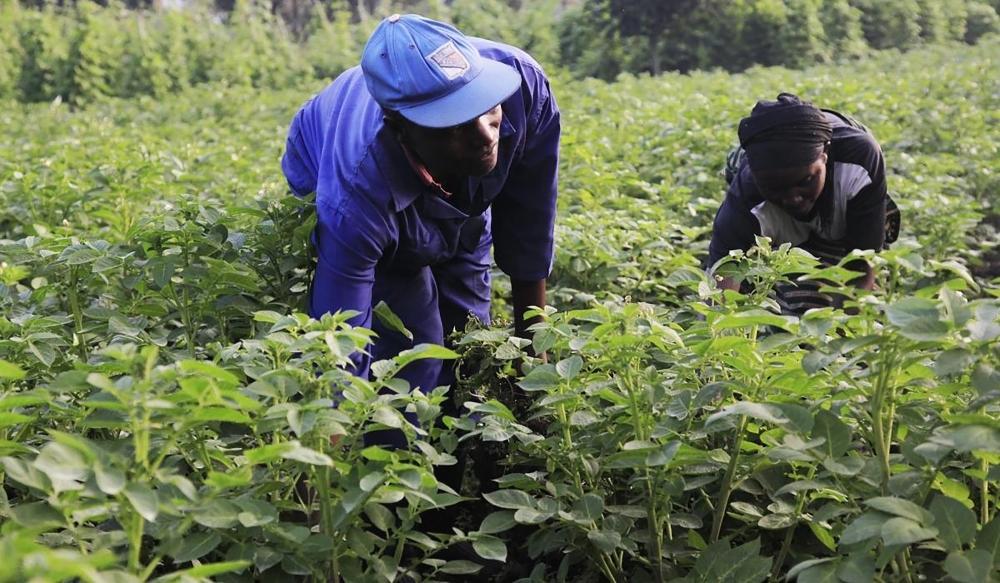Africa-Press – Rwanda. The Rwandan government has announced an investment of Rwf75 billion in the seeds and fertilizer subsidy programme to increase agricultural productivity during the 2025 agricultural season A and B.
Up to Rwf61 billion will be channeled into subsidizing mineral fertilizers while the remaining Rwf14 billion will go toward quality seeds, officials said.
According to Egide Gatari, the Agricultural Input Subsidies Program Manager at Rwanda Agriculture and Animal Resources Development Board (RAB), this initiative will benefit every farmer; from backyard kitchen gardeners to those cultivating over 100 hectares.
“The government remains committed to ensuring that all farmers, whether in Kigali, in provinces or even institutions such as correctional facilities and schools, public and private, have access to seeds and fertilizers. This is part of the broader goal to strengthen food self-sufficiency and increase the national food basket,” Gatari explained.
He highlighted that Season A, which begins in September and ends in February, is expected to bring abundant and prolonged rainfall, a critical factor that, when properly utilized, could yield up to 70 per cent of the anticipated harvest especially for crops like maize, wheat, and soybeans.
Gatari emphasized the importance of preparation, stating that registration for the subsidy has already begun through mobile phones. Farmers need only their national ID and the Unique Parcel Identifier (UPI) of the land where they intend to farm.
“Farmers must first register through the Smart Nkunganire System (SNS) by dialing *774# and following the instructions. If they don’t own a mobile phone, they can use one belonging to a family member, an agricultural advisor, or a local agro-promoter,” he said.
The information submitted into the SNS includes the farmer’s ID number and the UPI.
According to the new subsidy guidelines effective from July 01, the government will subsidize improved seeds for maize, wheat, and soybeans that are locally produced and only 29 certified private companies, under contract with RAB, are authorized to supply these seeds within the subsidy framework.
How much does a farmer pay?
Gatari also broke down the updated price structure for commonly used fertilizers.
This season, 1 kilogramme of UREA fertilizer will cost Rwf1,190. The government will cover Rwf380, leaving the farmer to pay Rwf810, he said.
For DAP, the full price is Rwf1,693 with a Rwf761 subsidy, and the farmer pays Rwf932. NPK will be priced at Rwf1,369, with the state covering Rwf561, and the farmer contributing Rwf808, he noted.
On seed prices, hybrid maize seeds (RHMH1601 and RHMH1611) will cost Rwf2,585, with Rwf1,800 subsidized and the farmer paying Rwf785.
Certified soybean seeds will be available at Rwf1,500, with a Rwf855 government contribution and Rwf645 farmer share. Wheat seeds, priced at Rwf1,550, will be subsidized by Rwf850, with farmers paying Rwf700.
Gatari further noted that Rwanda has made significant progress in seed self-reliance.
“Previously, we imported 3,000 to 4,000 tons of seeds annually from countries like South Africa, Zambia, and Kenya. But last year alone, Rwanda processed nearly 7,000 tons domestically. The 29 seed companies participating in this subsidy programme are mostly Rwandan-owned, and only seeds produced locally are eligible for the government subsidy.”
On the quality control front, Gatari assured that all seeds come with a lot number and fertilizers with a batch number, enabling full traceability.
He also cautioned against illegal cross-border sales of subsidized inputs, which are sold cheaper in Rwanda than in neighboring countries.
“These subsidies come from Rwandan taxpayers. Selling them outside the country is a crime. Instead, why not farm with them and sell the produce abroad?” he said.
Because weather patterns vary across regions, the distribution of seeds and fertilizers also happens in phases.
In some parts like Musanze, planting has already begun, while in districts like Kayonza, farmers are still in the preparation phase.
Seraphine Uwitonze, a maize and soybean farmer in Kibungo sector, Ngoma District, told The New Times she has already begun preparing her one-hectare plot.
“For a hectare of land, I need between 20 to 25 kilograms of maize seeds. The exact amount can vary based on the specific variety and planting density,” she explained.
Jean Paul Gafigi, an agronomist working with private distributors of seeds and fertilizers, recalled the challenges Rwandan farmers used to face.
“A few years ago, farmers struggled not only with accessing improved seeds but also with securing market outlets for their produce,” Gafigi said.
“Today, they understand that good seeds bring good yields. With reliable markets and cooperative training programmes, agriculture is becoming a sustainable source of livelihoods.”
For More News And Analysis About Rwanda Follow Africa-Press






